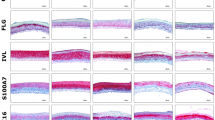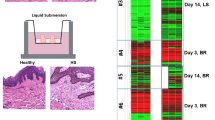Abstract
Atopic dermatitis (AD) is a common inflammatory skin disorder characterised by various epidermal alterations. Filaggrin (FLG) mutations are a major predisposing factor for AD and much research has been focused on the FLG protein. Human skin equivalents (HSEs) might be useful tools for increasing our understanding of FLG in AD and to provide a tool for the screening of new therapies aimed at FLG replacement. Our aim is to establish an explant HSE (Ex-HSE) for AD by using non-lesional skin from AD patients wildtype for FLG or harbouring homozygous FLG mutations. These Ex-HSEs were evaluated as to whether they maintained their in vivo characteristics in vitro and whether FLG mutations affected the expression of various differentiation markers. FLG mutations did not affect the outgrowth from the biopsy for the establishment of Ex-HSEs. FLG expression was present in healthy skin and that of AD patients without FLG mutations and in their Ex-HSEs but was barely present in biopsies from patients with FLG mutations and their corresponding Ex-HSEs. AD Ex-HSEs and AD biopsies shared many similarities, i.e., proliferation and the expression of keratin 10 and loricrin, irrespective of FLG mutations. Neither KLK5 nor Lekti expression was affected by FLG mutations but was altered in the respective Ex-HSEs. Thus, Ex-HSEs established from biopsies taken from AD patients maintain their FLG genotype-phenotype in vitro and the expression of most proteins in vivo and in vitro remains similar. Our method is therefore promising as an alternative to genetic engineering approaches in the study of the role of FLG in AD.



Similar content being viewed by others
References
Aho S, Harding CR, Lee JM, Meldrum H, Bosko CA (2012) Regulatory role for the profilaggrin N-terminal domain in epidermal homeostasis. J Invest Dermatol 132:2376–2385
Angelova-Fischer I, Mannheimer AC, Hinder A, Ruether A, Franke A, Neubert RH, Fischer TW, Zillikens D (2011) Distinct barrier integrity phenotypes in filaggrin-related atopic eczema following sequential tape stripping and lipid profiling. Exp Dermatol 20:351–356
Brown SJ, Irvine AD (2008) Atopic eczema and the filaggrin story. Semin Cutan Med Surg 27:128–137
Commandeur S, de Gruijl FR, Willemze R, Tensen CP, El Ghalbzouri A (2009) An in vitro three-dimensional model of primary human cutaneous squamous cell carcinoma. Exp Dermatol 18:849–856
Dale BA (1977) Purification and characterization of a basic protein from the stratum corneum of mammalian epidermis. Biochim Biophys Acta 491:193–204
Danso MO, van Drongelen V, Mulder A, van Esch J, Scott H, van Smeden J, El Ghalbzouri A, Bouwstra JA (2014) TNF-alpha and Th2 cytokines induce atopic dermatitis like features on epidermal differentiation proteins and stratum corneum lipids in human skin equivalents. J Invest Dermatol 134:1941–1950
El Ghalbzouri A, Gibbs S, Lamme E, Van Blitterswijk CA, Ponec M (2002) Effect of fibroblasts on epidermal regeneration. Br J Dermatol 147:230–243
El Ghalbzouri A, Hensbergen P, Gibbs S, Kempenaar J, van der Schors R, Ponec M (2004) Fibroblasts facilitate re-epithelialization in wounded human skin equivalents. Lab Invest 84:102–112
Fallon PG, Sasaki T, Sandilands A, Campbell LE, Saunders SP, Mangan NE, Callanan JJ, Kawasaki H, Shiohama A, Kubo A, Sundberg JP, Presland RB, Fleckman P, Shimizu N, Kudoh J, Irvine AD, Amagai M, McLean WH (2009) A homozygous frameshift mutation in the mouse Flg gene facilitates enhanced percutaneous allergen priming. Nat Genet 41:602–608
Hewett DR, Simons AL, Mangan NE, Jolin HE, Green SM, Fallon PG, McKenzie AN (2005) Lethal, neonatal ichthyosis with increased proteolytic processing of filaggrin in a mouse model of Netherton syndrome. Hum Mol Genet 14:335–346
Irvine AD (2007) Fleshing out filaggrin phenotypes. J Invest Dermatol 127:504–507
Irvine AD, McLean WH, Leung DY (2011) Filaggrin mutations associated with skin and allergic diseases. N Engl J Med 365:1315–1327
Janssens M, van Smeden J, Gooris GS, Bras W, Portale G, Caspers PJ, Vreeken RJ, Hankemeier T, Kezic S, Wolterbeek R, Lavrijsen AP, Bouwstra JA (2012) Increase in short-chain ceramides correlates with an altered lipid organization and decreased barrier function in atopic eczema patients. J Lipid Res 53:2755–2766
Kamsteeg M, Jansen PA, van Vlijmen-Willems IM, van Erp PE, Rodijk-Olthuis D, van der Valk PG, Feuth T, Zeeuwen PL, Schalkwijk J (2010) Molecular diagnostics of psoriasis, atopic dermatitis, allergic contact dermatitis and irritant contact dermatitis. Br J Dermatol 162:568–578
List K, Szabo R, Wertz PW, Segre J, Haudenschild CC, Kim SY, Bugge TH (2003) Loss of proteolytically processed filaggrin caused by epidermal deletion of Matriptase/MT-SP1. J Cell Biol 163:901–910
Man MQ, Hatano Y, Lee SH, Man M, Chang S, Feingold KR, Leung DY, Holleran W, Uchida Y, Elias PM (2008) Characterization of a hapten-induced, murine model with multiple features of atopic dermatitis: structural, immunologic, and biochemical changes following single versus multiple oxazolone challenges. J Invest Dermatol 128:79–86
Menon GK (2002) New insights into skin structure: scratching the surface. Adv Drug Deliv Rev 54 (Suppl 1):S3–S17
Mildner M, Jin J, Eckhart L, Kezic S, Gruber F, Barresi C, Stremnitzer C, Buchberger M, Mlitz V, Ballaun C, Sterniczky B, Fodinger D, Tschachler E (2010) Knockdown of filaggrin impairs diffusion barrier function and increases UV sensitivity in a human skin model. J Invest Dermatol 130:2286–2294
Moniaga CS, Kabashima K (2011) Filaggrin in atopic dermatitis: flaky tail mice as a novel model for developing drug targets in atopic dermatitis. Inflamm Allergy Drug Targets 10:477–485
Nirunsuksiri W, Presland RB, Brumbaugh SG, Dale BA, Fleckman P (1995) Decreased profilaggrin expression in ichthyosis vulgaris is a result of selectively impaired posttranscriptional control. J Biol Chem 270:871–876
O’Regan GM, Sandilands A, McLean WH, Irvine AD (2009) Filaggrin in atopic dermatitis. J Allergy Clin Immunol 124:R2–R6
Otsuka A, Doi H, Egawa G, Maekawa A, Fujita T, Nakamizo S, Nakashima C, Nakajima S, Watanabe T, Miyachi Y, Narumiya S, Kabashima K (2014) Possible new therapeutic strategy to regulate atopic dermatitis through upregulating filaggrin expression. J Allergy Clin Immunol 133:139–146
Oyoshi MK, Murphy GF, Geha RS (2009) Filaggrin-deficient mice exhibit TH17-dominated skin inflammation and permissiveness to epicutaneous sensitization with protein antigen. J Allergy Clin Immunol 124:485–493
Palmer CN, Irvine AD, Terron-Kwiatkowski A, Zhao Y, Liao H, Lee SP, Goudie DR, Sandilands A, Campbell LE, Smith FJ, O’Regan GM, Watson RM, Cecil JE, Bale SJ, Compton JG, DiGiovanna JJ, Fleckman P, Lewis-Jones S, Arseculeratne G, Sergeant A, Munro CS, El Houate B, McElreavey K, Halkjaer LB, Bisgaard H, Mukhopadhyay S, McLean WH (2006) Common loss-of-function variants of the epidermal barrier protein filaggrin are a major predisposing factor for atopic dermatitis. Nat Genet 38:441–446
Perusquia-Ortiz AM, Oji V, Sauerland MC, Tarinski T, Zaraeva I, Seller N, Metze D, Aufenvenne K, Hausser I, Traupe H (2013) Complete filaggrin deficiency in ichthyosis vulgaris is associated with only moderate changes in epidermal permeability barrier function profile. J Eur Acad Dermatol Venereol 27:1552–1558
Presland RB, Boggess D, Lewis SP, Hull C, Fleckman P, Sundberg JP (2000) Loss of normal profilaggrin and filaggrin in flaky tail (ft/ft) mice: an animal model for the filaggrin-deficient skin disease ichthyosis vulgaris. J Invest Dermatol 115:1072–1081
Sakabe J, Yamamoto M, Hirakawa S, Motoyama A, Ohta I, Tatsuno K, Ito T, Kabashima K, Hibino T, Tokura Y (2013) Kallikrein-related peptidase 5 functions in proteolytic processing of profilaggrin in cultured human keratinocytes. J Biol Chem 288:17179–17189
Sandilands A, Terron-Kwiatkowski A, Hull PR, O'Regan GM, Clayton TH, Watson RM, Carrick T, Evans AT, Liao H, Zhao Y, Campbell LE, Schmuth M, Gruber R, Janecke AR, Elias PM, van Steensel MA, Nagtzaam I, van Geel M, Steijlen PM, Munro CS, Bradley DG, Palmer CN, Smith FJ, McLean WH, Irvine AD (2007) Comprehensive analysis of the gene encoding filaggrin uncovers prevalent and rare mutations in ichthyosis vulgaris and atopic eczema. Nat Genet 39:650–654
Sasaki T, Shiohama A, Kubo A, Kawasaki H, Ishida-Yamamoto A, Yamada T, Hachiya T, Shimizu A, Okano H, Kudoh J, Amagai M (2013) A homozygous nonsense mutation in the gene for Tmem79, a component for the lamellar granule secretory system, produces spontaneous eczema in an experimental model of atopic dermatitis. J Allergy Clin Immunol 132:1111–1120
Saunders SP, Goh CS, Brown SJ, Palmer CN, Porter RM, Cole C, Campbell LE, Gierlinski M, Barton GJ, Schneider G, Balmain A, Prescott AR, Weidinger S, Baurecht H, Kabesch M, Gieger C, Lee YA, Tavendale R, Mukhopadhyay S, Turner SW, Madhok VB, Sullivan FM, Relton C, Burn J, Meggitt S, Smith CH, Allen MA, Barker JN, Reynolds NJ, Cordell HJ, Irvine AD, McLean WH, Sandilands A, Fallon PG (2013) Tmem79/Matt is the matted mouse gene and is a predisposing gene for atopic dermatitis in human subjects. J Allergy Clin Immunol 132:1121–1129
Scott IR, Harding CR (1986) Filaggrin breakdown to water binding compounds during development of the rat stratum corneum is controlled by the water activity of the environment. Dev Biol 115:84–92
Smith FJ, Irvine AD, Terron-Kwiatkowski A, Sandilands A, Campbell LE, Zhao Y, Liao H, Evans AT, Goudie DR, Lewis-Jones S, Arseculeratne G, Munro CS, Sergeant A, O’Regan G, Bale SJ, Compton JG, DiGiovanna JJ, Presland RB, Fleckman P, McLean WH (2006) Loss-of-function mutations in the gene encoding filaggrin cause ichthyosis vulgaris. Nat Genet 38:337–342
Smola H, Thiekotter G, Fusenig NE (1993) Mutual induction of growth factor gene expression by epidermal-dermal cell interaction. J Cell Biol 122:417–429
Steinert PM, Marekov LN (1995) The proteins elafin, filaggrin, keratin intermediate filaments, loricrin, and small proline-rich proteins 1 and 2 are isodipeptide cross-linked components of the human epidermal cornified cell envelope. J Biol Chem 270:17702–17711
Stout TE, McFarland T, Mitchell JC, Appukuttan B, Timothy SJ (2014) Recombinant filaggrin is internalized and processed to correct filaggrin deficiency. J Invest Dermatol 134:423–429
Thakoersing VS (2012) Barrier properties of human skin equivalents: rising to the surface. Thesis, Leiden University, The Netherlands
Thakoersing VS, Gooris GS, Mulder A, Rietveld M, El Ghalbzouri A, Bouwstra JA (2012) Unraveling barrier properties of three different in-house human skin equivalents. Tissue Eng Part C Methods 18:1–11
van Drongelen V, Danso MO, Mulder A, Mieremet A, van Smeden J, Bouwstra JA, El Ghalbzouri A (2014) Barrier properties of an N/TERT based human skin equivalent. Tissue Eng Part A 20:3041–3049
van Drongelen V, Alloul-Ramdhani M, Danso MO, Mieremet A, Mulder A, van Smeden J, Bouwstra JA, El Ghalbzouri A (2013) Knock-down of filaggrin does not affect lipid organization and composition in stratum corneum of reconstructed human skin equivalents. Exp Dermatol 22:807–812
Vavrova K, Henkes D, Struver K, Sochorova M, Skolova B, Witting MY, Friess W, Schreml S, Meier RJ, Schafer-Korting M, Fluhr JW, Kuchler S (2014) Filaggrin deficiency leads to impaired lipid profile and altered acidification pathways in a 3D skin construct. J Invest Dermatol 134:746–753
Williams H, Flohr C (2006) How epidemiology has challenged 3 prevailing concepts about atopic dermatitis. J Allergy Clin Immunol 118:209–213
Author information
Authors and Affiliations
Corresponding author
Additional information
Vincent van Drongelen and Mogbekeloluwa O. Danso share first authorship.
Rights and permissions
About this article
Cite this article
van Drongelen, V., Danso, M.O., Out, J.J. et al. Explant cultures of atopic dermatitis biopsies maintain their epidermal characteristics in vitro. Cell Tissue Res 361, 789–797 (2015). https://doi.org/10.1007/s00441-015-2162-3
Received:
Accepted:
Published:
Issue Date:
DOI: https://doi.org/10.1007/s00441-015-2162-3




